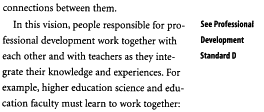Many textbooks make substantial use of margin materials other than notes. These are bits of text that are not "referenced" to a particular item in the main body of the text (as is generally the case with notes, regardless of where they are located). A "typical" example is shown below, a page from Reubens' Science and Technical Writing: A Manual of Style:

In this particular example, the margin items should probably be considered as headings, as discussed in Session 4.
Most marginal notes make use of the braille reference indicator (2356, 2356), using a Cell 7-5 format (reference marks start in Cell 7 with runovers in Cell 5). The transcriber generally must make some decision about the most appropriate place to insert the margin material. The types of marginal materials included here are commentaries, queries, and summaries.
The example below shows marginal material that is a repeat of what is already in the text. Since the most logical place to put this marginal material would be after the same text in the narrative proper, the transcriber could be omitted in this case. A transcriber's note indicating this omission should be included on the TN page in Volume 1:

This next example, from the National Science Education Standards handbook, presents an example of a commentary. One way to transcribe this is viewable in a separate window:

The rule for marginal material is worthwhile reading!
|